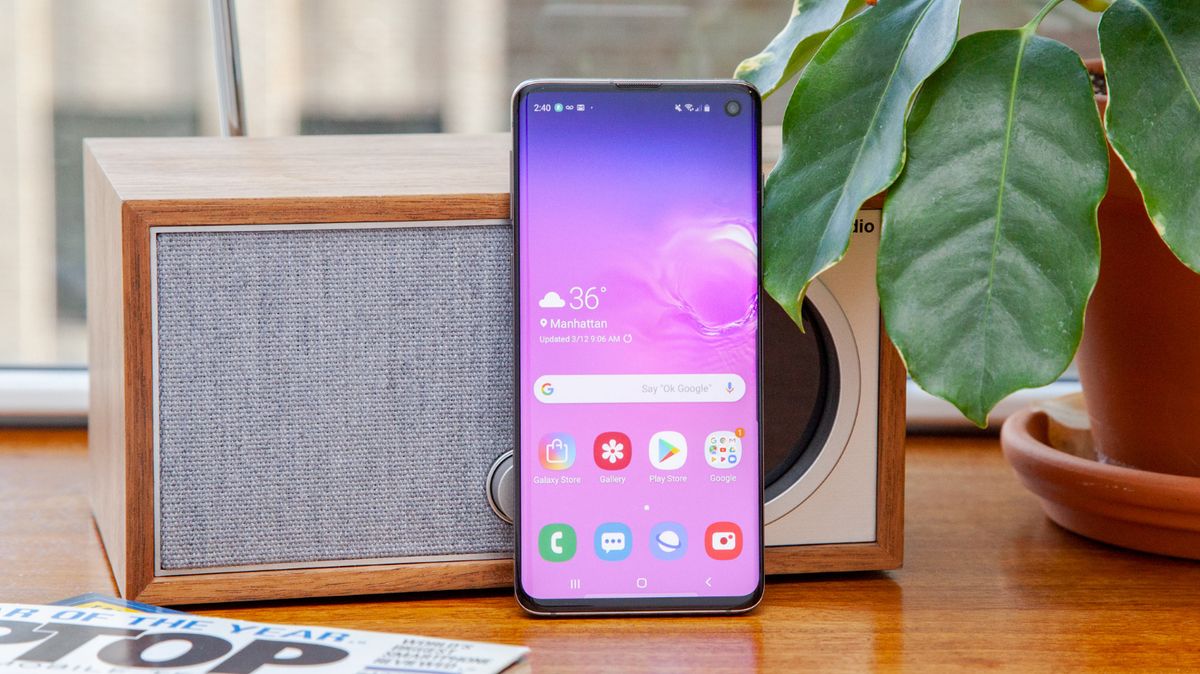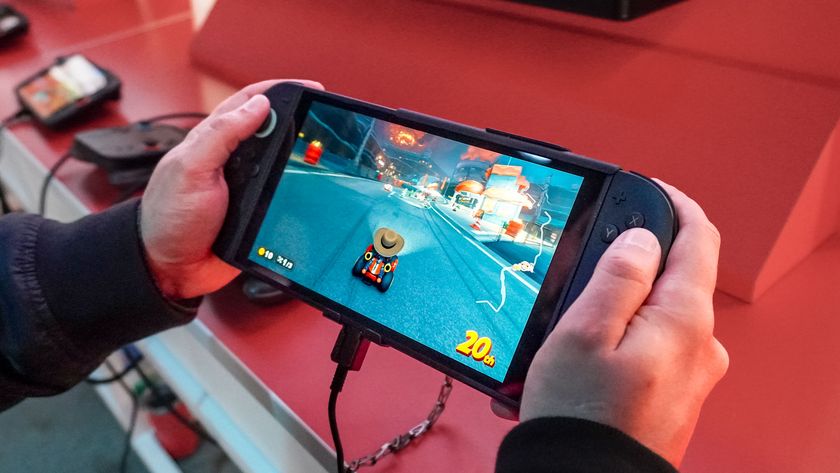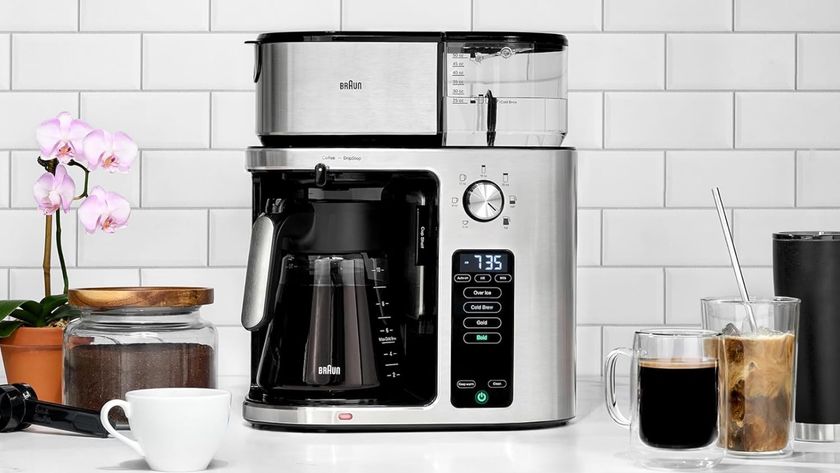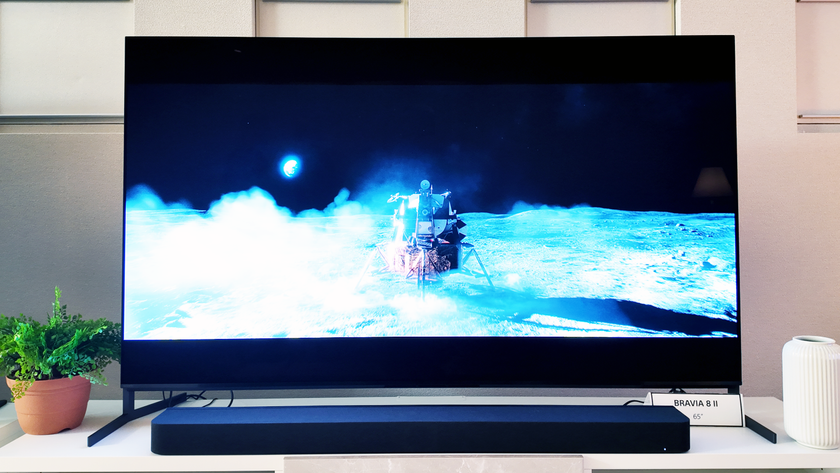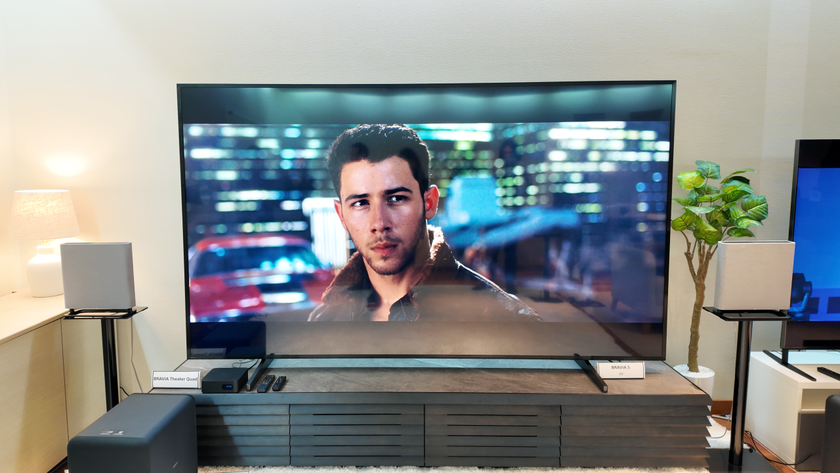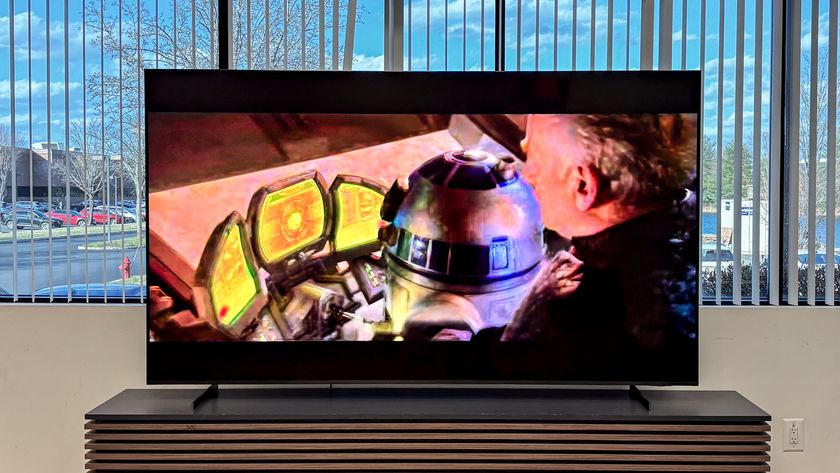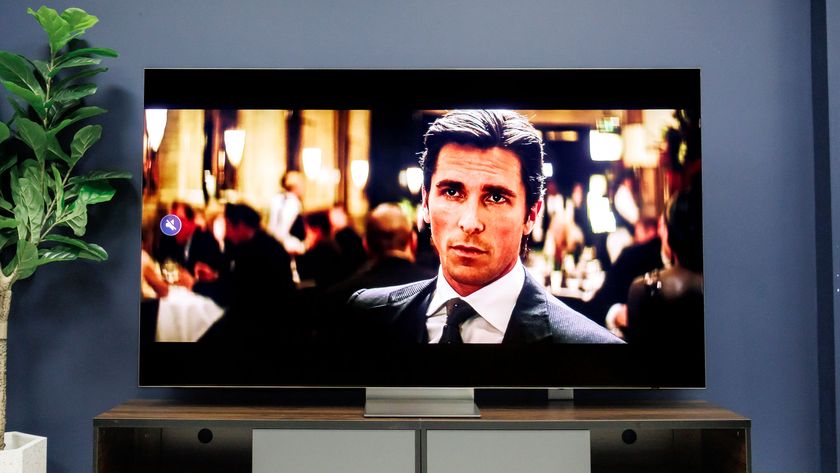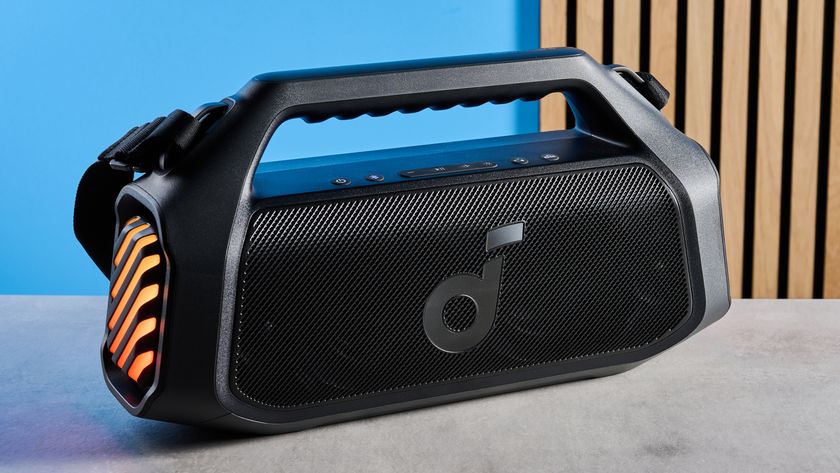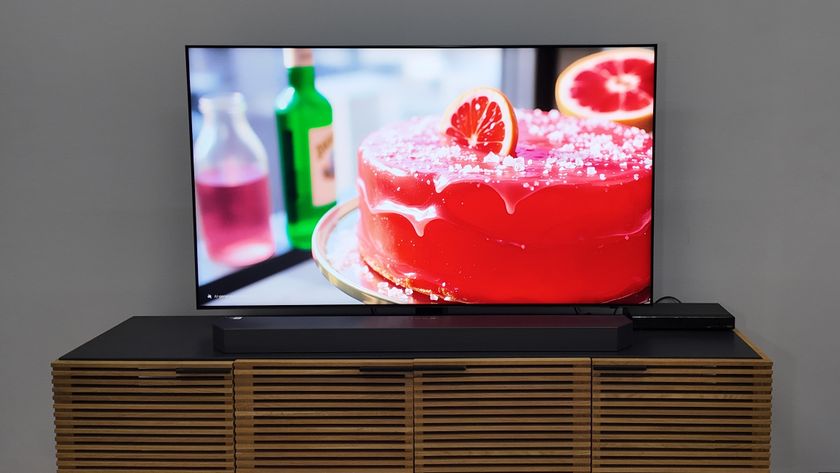Tom's Guide Verdict
The 6.1-inch Galaxy S10 may be the middle child of the S10 lineup, but don't sleep on this powerful smartphone or its beautiful display.
Pros
- +
Gorgeous Infinity-O display
- +
Solid battery life with Wireless PowerShare
- +
Blazing-fast performance
- +
Triple-lens camera system captures every angle
Cons
- -
Facial recognition needs work
- -
Front-facing camera not quite as good as on S10+
Why you can trust Tom's Guide
Make way, Galaxy S10. The Samsung Galaxy S20 series is here, which bring advanced cameras, 120Hz displays and improved performance to the company's flagship phone.
That brings up an interesting question: should prospective buyers entertain one of the newer models, or snag a Galaxy S10 on the cheap, while many retailers have heavily discounted their stock?
That all depends on how badly you want the S20's upgrades. The S20 models packs 5G connectivity and Snapdragon 865 power; a triple-lens rear camera with a 48-megapixel, 3x optical zoom lens; a 120Hz display; and a larger, 4,000-mAh battery, among other upgrades. es.
You could save nearly a quarter of what the S20 costs and still get one of last year's finest phones in the Galaxy S10, with its dazzling OLED display and great (if not class-leading) cameras that come alive when shooting low light. Even with the S20 looming large, the S10 is still every bit the jack-of-all-trades premium Android handset it was when it launched — not to mention one of the best smartphones money can buy.
If you're on the fence, be sure to check our Galaxy S20 versus Galaxy S10 comparison to see all the differences. And see how Samsung's flagship stacks up against Apple's in our Galaxy S10 vs iPhone 11 Pro face-off.
Samsung Galaxy S10 review: Price and availability
You can buy a Galaxy S10 from all major retailers. The big four U.S. carriers — AT&T, Verizon, Sprint and T-Mobile — carry the S10, as do U.S. Cellular and Xfinity Mobile. You can also order an unlocked Galaxy S10 online.
Following the Galaxy S20's launch, Samsung began offering the 128GB Galaxy S10 for $749 and the 512GB model for $899. Those models cost $899 and $1,149, respectively, before the S20 entered the picture. Check out our roundup of best Galaxy S10 deals as well as our Samsung promo codes for more opportunities to save.
Samsung Galaxy S10 review: Specs
| Price | $899 |
| Display (Resolution) | 6.1-inch Dynamic AMOLED (3040 x 1440) |
| Rear Camera(s) | 16-MP ultrawide (ƒ/2.2), 12-MP dual-pixel wide (ƒ/1.5, ƒ/2.4), 12-MP telephoto (ƒ/2.4) |
| Front Camera | 10-MP dual-pixel (f/1.9) |
| CPU | Qualcomm Snapdragon 855 |
| RAM | 8GB |
| Storage | 128GB, 512GB |
| microSD | Yes, up to 512GB |
| Battery | 3,400 mAh |
| Colors | Prism Black, Prism White, Prism Blue, Prism Green (except U.S.), Flamingo Pink (except U.K.) |
| Size | 5.9 x 2.77 x 0.3 inches |
| Weight | 5.5 ounces |
Samsung Galaxy S10 review: Display
Almost every other smartphone maker has eliminated bezels by adding a notch that swoops down from the top of the device to disguise the front-facing camera. Samsung avoided that trend altogether with all three Galaxy S10 models, instead developing the unique Infinity-O display, which embeds the front-facing camera lens directly in the screen.
The midsized S10 sports a hole-punch-size cutout for its single selfie lens, which is far less distracting than the S10 Plus' oval-shaped cutout.
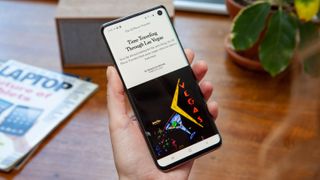
I read lengthy New York Times articles, raced my trusty Mitsubishi Lancer in Asphalt 9 and took multiple selfies with the S10, and the hole punch never took away from the experience. When snapping photos of myself, I realized that the obvious cutout ensured I always looked directly at the lens. For those of you who never seem to nail eye contact with the camera lens, the S10's cutout is a great feature, making this task ridiculously easy.
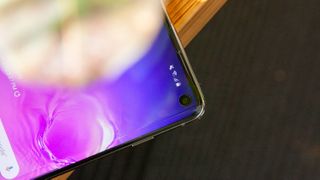
You can also hide the hole punch with Samsung's cleverly designed wallpapers. That won't help when you're streaming videos or browsing the web, but the disguise looks pretty damn good when you show it off to friends. The slightly curved glass practically cascades from the phone's frame. That curved glass also makes it a little too easy to accidentally press something simply because you were holding the device; this was also a problem in past generations of Galaxy phones. If you want to hide the cutout altogether, that’s an option, but that effect is so ugly that you may as well buy another Android device with a notch and call it a day.
The S10 broke DisplayMate's records for display brightness, color accuracy and image contrast, and the list goes on, so the S10 earned an A+ for a virtually perfect display. We found the same in our testing. The S10's AMOLED display covers 208.2 percent of the sRGB color gamut and notched a 0.38 Delta-E rating for color accuracy (numbers closer to 0 are better). The S10 hit a peak brightness of 611 nits when we shone a flashlight on its sensor, making the phone's panel almost as bright as that on the S10 Plus (625 nits). The Pixel 3 is ultra dim by comparison, hitting just 362 nits.
Samsung Galaxy S10 review: Design
Aside from the hole-punch display, the Galaxy S10 is the same as every other smartphone on the market. That's not a bad thing, but if you're waiting for innovative smartphone design before spending close to $1,000 (or far more) for a new device, you'll have to hold out for the foldable phones arriving this year.
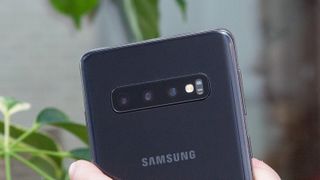
The 6.1-inch S10 has the exact same dimensions as Apple's 6.1-inch, $749 iPhone 11 but is more than a full ounce lighter. The S10 isn't a one-handed device for those of us with petite paws; the 5.8-inch S10e is both smaller and cheaper, so go for that device if size is the deciding factor for you in phone selection.
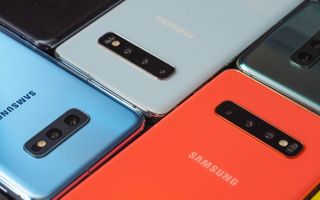
The S10 comes in the same colors as the larger $999 Galaxy S10 Plus, which offers a few simple options (like white and black) and some bolder ones (blue, Flamingo Pink). I tested the Prism Black model, which is a terribly boring glassy black slab. I suggest going with Prism White, or one of the more interesting hues, which will help you stand out. The black model collects so many fingerprints that you'll look like a really uncool forensics investigator.
Like all Galaxy S models, the S10 is rated IP68 water-resistant, meaning it can survive in up to 5 feet (1.5 meters) of water for a half-hour. That's respectable in the flagship phone realm, and thus earns the Galaxy S10 a spot on our list of the best waterproof phones.
Samsung Galaxy S10 review: Cameras
The S10 and S10 Plus have one key difference, aside from the larger phone's bigger display: The Plus sports an additional 8-megapixel, depth-sensing, front-facing camera for better selfies. Both devices have a selfie-portrait effect, which enables other effects, including wind-swept and black-and-white backgrounds.

But the S10 achieves those effects using software instead of an additional depth-sensing lens, and it shows when comparing the two side by side.
As you can see in the black-and-white Live Focus image above, the S10's camera software gets a little messy around my curls. Meanwhile, the S10 Plus seamlessly softens the background around them, creating a more natural effect.
Otherwise, the S10 and S10 Plus have the same rear triple-lens camera array, with telephoto, standard and wide-angle shooters for capturing a variety of viewpoints. I compared the S10 with a Pixel 3 by capturing a Brooklyn storefront. Both images capture the detail in the brick and the gleam of the coffee shop's sign, but the S10 is more color-accurate; the neon "No Sleep Till" sign glowed more yellow than blue-white in real life.
I also compared the S10's telephoto lens and optical zoom with the iPhone XS cameras by playing tourist with a photo of the Statue of Liberty as seen from the Brooklyn Heights Promenade. It's an almost impossible shot, because Lady Liberty is extremely far away and the midday sun is not helpful. The iPhone's optical zoom fared better, as the S10's image is darker, with more artifacts in the photo.
The S10's cameras are good, though if you want more dramatic photos, the Pixel 3 and newer Pixel 4 remain better options, while the latest iPhones capture more-natural shots.
Samsung Galaxy S10 review: Security
Samsung can't compete with Apple on biometric authentication, and we're not sure the Galaxy maker is even trying. This is one area where Samsung needs to work harder to ensure that unlocking your phone and authenticating payments are locked down with the most secure biometric scans that money can buy.
In our testing, the S10's facial recognition is easily fooled by a photograph of a person's face. That's just plain embarrassing. The photo trick doesn't work if you turn off Fast Facial Recognition in the S10's settings, but the facial-authentication method is still less secure than it should be. That's because Samsung doesn't use hardware to create a 3D map of your face the way Apple does with its Face ID.
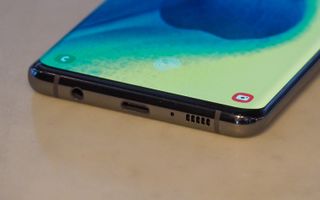
The S10's in-display reader is more secure, due to an ultrasonic sensor that maps the 3D curves of your fingerprint. You have to press a little longer on the sensor than you would think, but the phone unlocks quickly enough, and I appreciate that it's not a two-step process, like on the iPhone XS. (On that phone, you have to wait for the camera to scan your face and then swipe up.)
There have been some complaints about the Galaxy S10's ultrasonic fingerprint sensor not working properly when a screen protector is applied to the phone. In fact, one woman claims that anyone could unlock her Galaxy S10 after she purchased a screen protector off of eBay. Fortunately, Samsung issued an update designed to fix this problem shortly after release.
Samsung Galaxy S10 review: Performance
The Galaxy S10 Plus and smaller S10 have the same exact specs, and it shows in their performance power. With Qualcomm's 7-nanometer Snapdragon 855 processor and 8GB of RAM, the S10 easily matches the larger S10 Plus' speed.
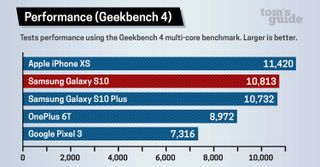
The two devices scored evenly on Geekbench 4, a synthetic test of overall system performance. The S10 notched a multicore score of 10,813, sneaking just ahead of the larger phone's performance (10,732). Both phones lag behind the iPhone XS' A12 Bionic processor, which blows away the competition with a 11,420 score.
But both S10s handily crush their Android rivals, including the Pixel 3 (7,316) and OnePlus 6T (8,972).
MORE: Best phones: Here are the 10 best available
And the S10, like the S10 Plus, pulled ahead of both the iPhone and competing Android flagships in the 3DMark Slingshot Extreme graphics-performance benchmark. The S10 notched a score of 5,606 on the OpenGL ES 3.1 test, just behind the larger S10's score (5,648) and easily ahead of the results from the OnePlus 6T (5,183), Pixel 3 (4,396) and iPhone XS (4,339).
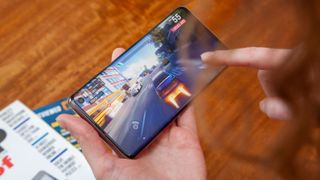
I unlocked one premium race car after another in my favorite graphics-intensive game, Asphalt 9, easily killing 45 minutes burning rubber around the globe. The S10 never lagged or felt warm to the touch.
Samsung Galaxy S10 review: Battery life
The Galaxy S10's 3,400-mAh battery isn't as large as the massive, 4,100-mAh pack inside the S10 Plus. And as expected, the smaller device doesn't last as long on a charge, though you can still go a long time without topping off your battery.

The S10 eked out 10 hours and 19 minutes on the Tom's Guide Battery Test, which consists of continuous web surfing over 4G LTE. The S10 Plus landed near the top of our list of longest-lasting smartphones, reaching 12 hours and 35 seconds on that test.
MORE: Smartphones with the longest battery life
The Galaxy S9 Plus, released in 2018, also lasts longer on a charge than the S10, but that older phone has a slightly larger, 3,500-mAh battery. The S10e and its smaller, 3,100-mAh unit died after 9 hours and 42 minutes. The S10 outlasted both the iPhone XS (9:41) and the Pixel 3 XL (9:30). In the iPhone 11 Pro vs. Samsung's S10 face-off, the Pro lasted four minutes longer (10:23) than the S10.
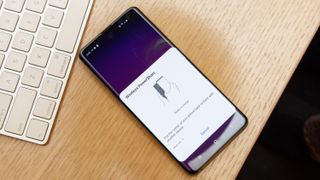
All three Galaxy S10 models have a new Wireless PowerShare feature that we wish every smartphone on the market offered. The tool, which you toggle on in the shortcuts menu by swiping down, lets you charge up any Qi-compatible device.
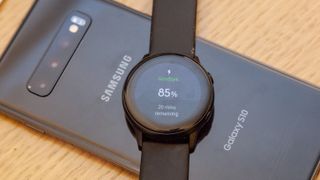
I used this to charge up Samsung's Galaxy Watch Active, and the process works quickly and seamlessly.
Samsung Galaxy S10 review: Software
The OneUI software on the Galaxy S10 is streamlined as promised and fairly to easy to use. The settings menu, for example, presents a lot fewer options than previous Galaxy phones.
By default, there’s a Recent Apps, Home Button and Back button along the bottom of the display. But you can switch to full-screen gestures. You'll swipe up from the bottom left to see recent apps, up from the bottom to go home and up from the right to go back.
The Galaxy S10 also now offers some of the more compelling software features of the Galaxy Note 10. These include Live Focus video for applying bokeh effects to your footage and Samsung DeX for PC, which allows you to see notifications and send and receive messages on your laptop without having to fire up your phone.
Samsung Galaxy S10 review: Verdict
Even more than a year since its release, the Galaxy S10 offers superfast performance and a beautiful display, with a less distracting camera cutout than on the larger, pricier S10 Plus. I also love that the S10 offers my favorite feature, Wireless PowerShare. That means you don't have to splurge on the priciest Galaxy to reverse-charge all of your devices.
Apple and Google's latest flagships sport better cameras, depending on whether you prefer more dramatic or more natural shots. And if you want longer battery life, the S10 Plus is a better bet, provided you can handle a larger, 6.4-inch screen. We do prefer the S10 to the value-priced OnePlus 6T, based on our face-off.
Sure, the Galaxy S20's redesigned triple-camera stack and 5G connectivity could put the Galaxy S10's photography and data speeds to shame. But at the end of the day, if all you're looking for is a well-rounded, well-crafted Android flagship that can do it all — including work with a pair of good old-fashioned wired headphones — for a price you can sleep easy at night spending, the Galaxy S10 remains an unbeatable proposition.
Caitlin is a Senior editor for Gizmodo. She has also worked on Tom's Guide, Macworld, PCWorld and the Las Vegas Review-Journal. When she's not testing out the latest devices, you can find her running around the streets of Los Angeles, putting in morning miles or searching for the best tacos.
